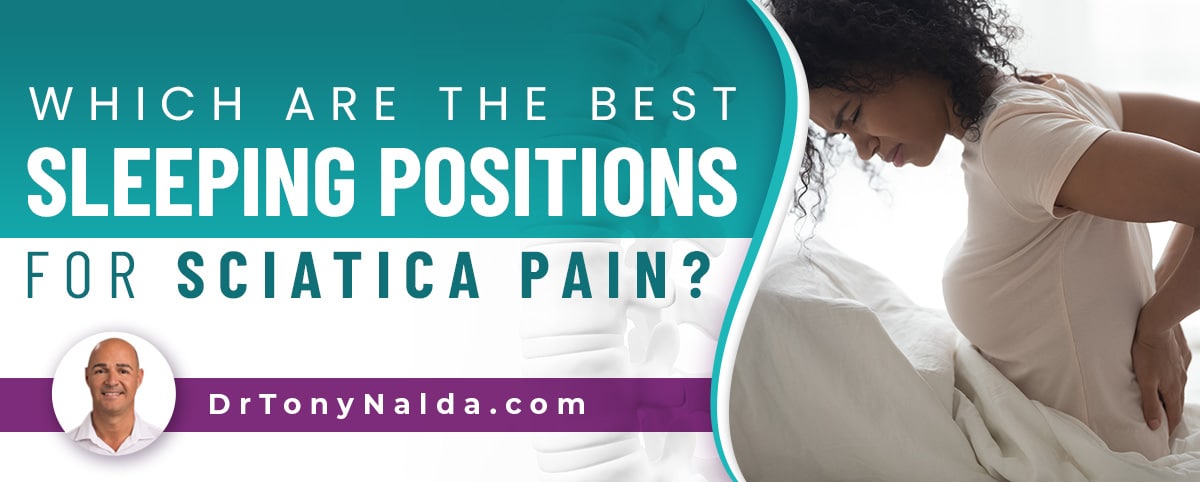Which Are The Best Sleeping Positions For Sciatica Pain?

It's said that most people will experience lower back pain at some point in their lives; as the lumbar spine has to support the weight of the trunk, the spinal sections above, and feels the effects of lifting, bending, and twisting motions, the nerves of the lower back are also vulnerable, including the sciatic nerve.
For those experiencing sciatic nerve pain, it tends to get worse at night, and knowing the best sleeping position for sciatica can help. Preference can range from patient to patient, but in most cases, sleep positions that promote spinal alignment, such as sleeping flat on the back, are best.
Before getting to the specifics of how to sleep with sciatica, let's first start by exploring the nature of sciatic nerve pain.
Table of Contents
What is Sciatica?
Most people hear the term sciatica and think it's the name of a condition; however, sciatica is not a medical condition, and is more accurately understood as a symptom of an underlying issue/condition.
The sciatic nerve is the longest in the body, starting in the lumbar spine and extending down the back of the hip, buttock, leg, and into the foot.
In most cases, sciatic nerve pain is felt down the body's left side, but can also affect the right, and rarely involves both sides of the body.
 If the sciatic nerve is exposed to uneven pressure anywhere along its extensive pathway, it can become irritated and cause sciatic nerve pain.
If the sciatic nerve is exposed to uneven pressure anywhere along its extensive pathway, it can become irritated and cause sciatic nerve pain.
Sciatic nerve pain can range widely from patient to patient, so let's focus on some common symptoms.
Sciatica Symptoms
Sciatic nerve pain can range from mild and intermittent to chronic pain that impacts quality of life.
In most cases, people who suffer from sciatica experience flare ups: periods of time during which symptoms intensify, and other periods during which symptoms are mild and/or abate completely.
When sciatic nerve roots are compressed, this means they have less room to function within, and pinching the sciatic nerve is associated with the following symptoms, any one of which can affect a person's ability to get a good night's sleep:
- Hip pain
- Pain in the buttock
- Leg pain (sharp or dull)
- Foot pain
- Lower back pain
- Tingling sensations throughout the lower body
- Electric shock-like sensations
- Intense shooting pains
- Mobility issues with the lower body
- Bowel and/or bladder control issues (associated with severe cases)
Anyone who has struggled with back pain knows how disruptive it can be to sleep; whether back pain is worse at night, wakes a person up, or is making it difficult to find that perfect sleeping position, sciatic pain will only increase with insufficient sleep.
Dealing with Sciatica Pain at Night
Sciatica pain is known to be worse at night, but that can be said of most types of pain.
Lying quietly at the end of the day means no distractions, and this means it's harder to ignore the body's aches and pains.
In addition, certain positions are also known to exacerbate sciatic nerve pain, which is where having a strategy for promoting sleep quality can be helpful.
When it comes to the best way to sleep with sciatica, this can vary from patient to patient as mattress preference also has an impact.
Make sure that the mattress suits an individual's preference, such as choosing a medium to firm mattress, a soft mattress, or the addition of a body pillow.
If a certain type of mattress helps to reduce sciatica pain, this can also help with finding a comfortable position during sleep.
Sleep Positions and Sciatica
A person's preferred sleep position is highly personal, but when it comes to the ability to alleviate sciatica symptoms during the night, a sleep position that promotes spinal alignment is best.
The spine consists of vertebrae (bones) stacked on top of one another in a straight and neutral alignment, and a spine that's aligned has its natural curves in place and is going to function optimally.
Sleep positions that put the spine in unnatural positions or introduce adverse spinal tension can exacerbate sciatica symptoms by applying more pressure to the sciatic nerve.
Sleeping Flat on the Back
 The single best sleep position for spinal health is flat on the back.
The single best sleep position for spinal health is flat on the back.
Sleeping flat on the back means the body's weight is evenly distributed along the entire length of the spine, the spine's natural alignment is preserved, pressure points are minimized, and no additional spinal tension is being introduced.
Sleeping flat on the back means the spinal nerve is not experiencing uneven pressure, and this can improve sleep position quality.
Side Sleeping
The next best sleep position is sleeping on the side, and when it comes to sciatic nerve pain relief, sleeping on the side opposite to the side of the body experiencing sciatica pain is best.
So as most people's sciatica is felt down the left side of the body, sleeping on the ride side can help minimize pressure felt on the left side by elevating the side of the body affected by sciatica.
A pillow between your knees and/or one between the waist and the mattress, if there is a noticeable gap, can further align the spine and provide it with more support, taking pressure off its surrounding muscles and nerves.
A pillow between your knees during side sleeping also helps by keeping the spine and pelvis in a neutral alignment, while preventing the legs from rotating during sleep.
Stomach Sleepers
The worst sleeping position for spinal health and sciatic nerve pain is flat on the stomach, and this is because it places the spine in an unnatural arch/position, and the neck has to be turned at an awkward angle, straining the cervical spine.
Fetal Position
While some people who suffer from sciatica find the fetal position uncomfortable, others can find that it relieves sciatica pain by opening up the spaces between the vertebral bodies, relieving pressure on the sciatic nerve.
In the end, sleep position is a personal choice, and when it comes to sciatic nerve pain, whatever a person finds to be the most comfortable position for sleep is going to offer the most in terms of pain reduction.
Sleeping with sciatica can be challenging, and while knowing the best sleep position can help, the best way to deal with any sciatica symptom is to determine its underlying cause so it can be treated proactively for long-term sustainable pain relief.
Sciatica Causes
Sciatica can have a number of causes, and as mentioned, in order for any type of long-term pain relief, the source of the sciatic nerve compression has to be addressed.
The most common cause of sciatica is a herniated disc.
The spinal discs facilitate flexible movement, provide the spine with structure, act as the spine's shock absorbers, and provide cushioning between adjacent vertebrae to prevent friction during movement.
If a disc in the lumbar spine starts to deteriorate, and the discs are generally the first spinal structures to experience age and/or lifestyle-related spinal degeneration, it can become desiccated and herniated.
A herniated disc means that its inner nucleus has pushed through a tear in its outer annulus and is encroaching on the space in and around the spine: space needed for the nerves to function optimally.
Additional spinal conditions such as stenosis of the lumbar spine (a narrowing of the spinal canal) and/or spondylolisthesis, when one vertebral body shifts out of alignment with the rest of the spine and onto the vertebra below, can also cause the sciatic nerve to be impinged and irritated.
Conclusion
Not only can sciatica make keeping up with daily tasks and responsibilities difficult, it can also make it harder to get a good night's sleep.
Having healthy sleep habits is important for everyone, but for those dealing with the additional challenge of sciatic nerve pain, it can be particularly beneficial by fostering an internal environment that's conducive to healing.
Sciatica pain can come and go, and while many cases of sciatic nerve pain will remedy themselves within a period of weeks or months, others that are caused by the presence of an underlying spinal condition will require proactive customized treatment shaped around the underlying cause.
Here at the Scoliosis Reduction Center, once I determine what's causing a patient's sciatic nerve pain, I can start crafting a treatment plan around it, and this often involves condition-specific chiropractic care and physical therapy.
Addressing the cause of a symptom is key to long-term sustainable treatment results; while the prescription of pain medications can help with short-term pain relief during flare ups, unless the underlying cause of the pain is addressed, it will continue and can increase over time.
The best way to sleep with sciatica is in the position that feels the most comfortable, and is the best for spinal health by promoting a healthy alignment and takes pressure off the sciatic nerve: sleeping flat on the back or on the side.
Dr. Tony Nalda
DOCTOR OF CHIROPRACTIC
After receiving an undergraduate degree in psychology and his Doctorate of Chiropractic from Life University, Dr. Nalda settled in Celebration, Florida and proceeded to build one of Central Florida’s most successful chiropractic clinics.
His experience with patients suffering from scoliosis, and the confusion and frustration they faced, led him to seek a specialty in scoliosis care. In 2006 he completed his Intensive Care Certification from CLEAR Institute, a leading scoliosis educational and certification center.
About Dr. Tony Nalda
 Ready to explore scoliosis treatment? Contact Us Now
Ready to explore scoliosis treatment? Contact Us Now





